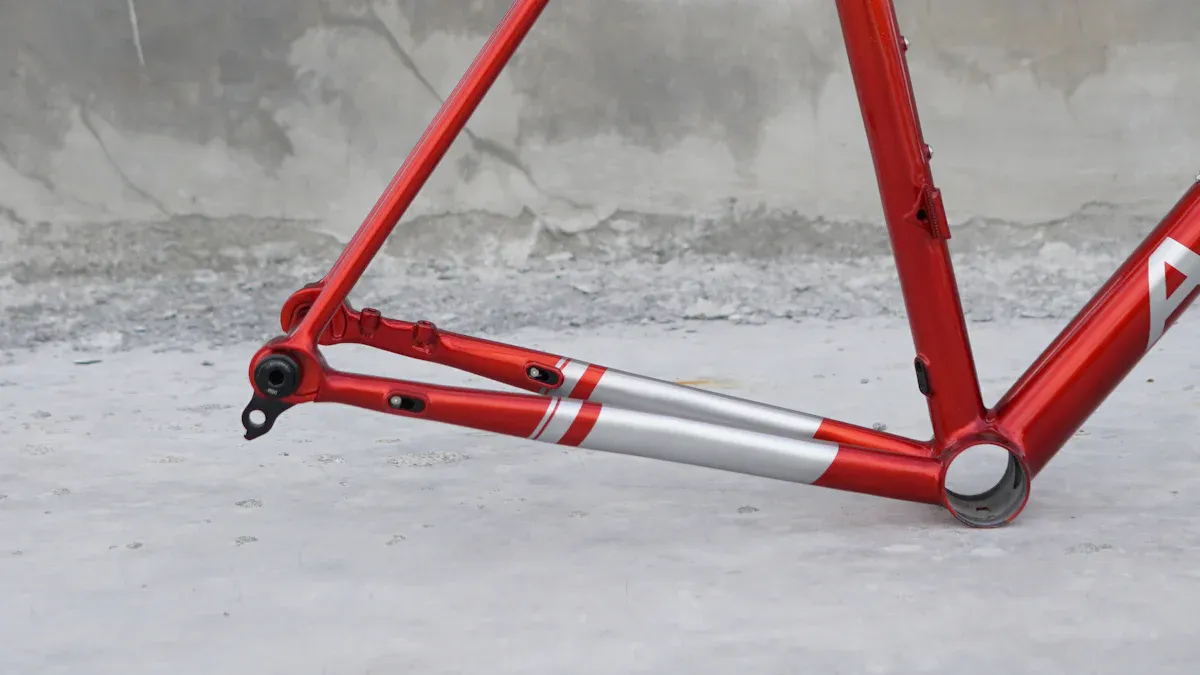
Choosing the right material for your commuter bike frame in 2025 affects your daily ride. Things like strength, weight, and comfort matter a lot. They affect how well your bike works in the city. Strength is very important, especially for heavier riders. They need strong frames to stay safe. You should also think about comfort features. Ergonomic saddles and shock-absorbing parts can make your ride better. Also, many bike buyers care about being eco-friendly. They want their choices to help the environment. Finally, prices can be very different. It’s important to find a good balance for your budget and commuting needs.
Key Takeaways
Steel frames are strong and last a long time. They absorb shocks well but are heavier and need rust care.
Aluminum frames are light and cheap. They are good for city riding but might not feel comfy on bumpy roads.
Titanium frames are strong and comfy. They last a long time but are more expensive.
Carbon fiber frames are the lightest and give smooth rides. They need careful handling and cost more money.
Think about your budget, comfort needs, and eco-friendliness when picking the best frame material for daily commuting.
Steel Bike Frame Materials

Steel bike frames are a popular choice for commuters. They have special qualities that make them different from other bike frame materials.
Strength and Durability
When you pick a steel bike frame, you get great strength and durability. Steel frames can handle a lot of stress and rough roads. This makes them perfect for daily commuting. The main types of steel used in bike frames are carbon steel and alloy steel.
Carbon Steel: Has up to 2.1% carbon. It is strong and versatile.
Alloy Steel: Has elements like chromium and nickel. These make it stronger and resist rust.
These materials have high tensile strength. This means your bike can handle city riding well. Steel frames also last a long time. With proper care, they can last a lifetime. Unlike aluminum or carbon frames, which can weaken, steel stays strong. If damaged, steel can often be repaired. This is a big plus because you can easily weld a bent frame back together. This helps it last longer.
Vibration Absorption
Another great thing about steel bike frames is how they absorb vibrations. This helps give you a smoother ride, especially on bumpy roads. Some studies say tire size and pressure matter more for vibration absorption. Still, many riders enjoy the comfort steel frames provide.
Steel frames, especially those made from chromoly, are good at absorbing road vibrations. This leads to a comfy ride, even on rough roads.
Compared to aluminum frames, which are stiffer, steel gives a softer experience.
The flexibility of steel helps it absorb shocks from bumps and pedaling. This means it won’t get damaged easily. This quality balances weight and comfort, making steel frames a great choice for commuters.
Aluminum Bike Frame Materials
Aluminum bike frames are a popular pick for commuters in 2025. They have many benefits that make them different from other bike materials.
Lightweight and Affordable
One big advantage of aluminum frames is that they are light. Usually, aluminum frames weigh between 1400 to 1800 grams. This makes them lighter than steel frames, which are heavier, but heavier than carbon fiber frames, which can weigh as little as 700 grams. The light design helps you move easily through city traffic.
Aluminum frames also cost less. They give good value for commuters. In 2025, aluminum frames are some of the cheapest options for high-quality bike materials. They are cheaper than carbon fiber and titanium frames, which can be very expensive. The low cost of aluminum comes from how easy it is to make and mass-produce. This means you can find a good bike without spending too much money.
Tip: When looking for a commuter bike, think about the total cost-per-mile. Aluminum frames often give the best mix of performance and price.
Ride Comfort
Even though aluminum frames are light and cheap, they have some downsides for ride comfort. Aluminum can pass on more road vibrations than steel or carbon fiber. This can make the ride feel harder, which might not be as nice on bumpy roads. But you can fix this by choosing wider tires or adding suspension parts.
Many riders find that using wider tires (around 32 mm) can really help comfort, making the differences between frame materials less clear. Even with some comfort issues, aluminum frames are still a smart choice for daily commuting. They give a good mix of strength, light design, and cost, making them a popular choice for many cyclists.
Titanium Bike Frame Materials
Titanium bike frames are a great choice for commuters in 2025. They have special features that make your ride better.
Flexibility and Comfort
One big thing about titanium is its natural flexibility. This helps the frame absorb bumps from the road. Because of this, you get a smoother and more comfy ride, especially on long trips. The mix of being stiff and flexible makes titanium great for long rides. You can cycle for hours without getting tired. The frame reduces shocks and vibrations better than many other materials.
Also, titanium frames give a nice ride because of their shape and material. They are light but strong, which is perfect for daily use. You can easily ride through city streets, knowing your bike can handle different conditions.
Cost Considerations
Even though titanium frames have many benefits, they cost more. In 2025, the average price for these frames is between $6,400 and $10,700. The price depends on the type of tubes used. For example, a titanium constant-wall tubeset starts at about $6,400. A multi-butted tubeset can go up to $9,200.
Even with the high price, titanium frames save you money over time. They are very strong and resist rust, often lasting for decades with little care. Unlike steel, which can rust, or aluminum, which can wear out, titanium needs less maintenance. Most costs come from changing other parts, not the frame. This long life makes titanium a smart choice for riders who want to keep their bikes for a long time.
Tubeset Type / Model | Starting Price (USD) |
|---|---|
Titanium Constant-Wall Tubeset | $6,400 – $7,400 |
Titanium Double-Butted Tubeset | $8,300 |
Titanium Multi-Butted Tubeset | $9,200 |
Carbon Tubes & Titanium Intersections | $9,000 – $10,700 |
Carbon Fiber Bike Frame Materials

Carbon fiber bike frames are special because of how well they perform. This makes them a great choice for city riding.
Shock Absorption
One big benefit of carbon fiber is how well it absorbs shocks. This material is really good at reducing vibrations. It helps you have a smoother ride on bumpy city streets. In fact, carbon fiber absorbs 30% more road vibrations than aluminum. This means you feel less tired during your daily rides.
Carbon fiber frames are light but strong. This improves how your bike handles and responds.
The way carbon fiber is made lets it absorb shocks better than aluminum and steel. This flexibility makes your ride more comfortable by reducing bumps.
Many riders say their carbon fiber bikes feel much smoother, even on rough roads. You might notice that the tire pressure feels lower than it is because the frame absorbs impacts so well.
Durability Concerns
Even though carbon fiber performs well, it has some durability issues. It is strong in one direction but can get damaged from sharp hits. For example, if a heavy lock pulls on the frame, it might crack.
Carbon fiber frames need careful handling, especially when locking your bike. Wrong locking methods can cause damage.
Unlike steel, which can rust, carbon fiber is better against weather problems. But it can break suddenly if hit hard, so checking your frame after crashes is important.
Despite these issues, good quality carbon fiber frames made for strength can handle commuting well. They usually last longer than aluminum frames, which can crack and wear out over time.
Material Comparison for Commuter Bike Frames
When you pick a commuter bike frame, think about how different materials compare. Two important things to consider are weight versus strength and cost versus sustainability. Knowing these comparisons can help you make a smart choice.
Weight vs. Strength
The strength-to-weight ratio of bike frame materials affects your commuting experience a lot. Here’s how each material does:
Material | Strength-to-Weight Ratio | Advantages | Disadvantages |
|---|---|---|---|
Aluminum | Excellent | Cheap, light, stiff, made with modern methods | Short lifespan, hard to fix if broken |
Steel | Moderate | Strong, easy to shape and fix, good at absorbing bumps | Heavy, can rust, not as common |
Carbon Fiber | Outstanding | Very light and strong, can be shaped in many ways | Costly, complicated to make |
Titanium | Good | Strong, resists rust, comfortable to ride | Less common, more expensive |
From this table, you can see that aluminum gives a great mix of weight and strength, making it popular for commuters. But it might wear out faster than other materials. Steel is tough and easy to repair but is heavier. Carbon fiber is great for being light and strong, perfect for performance, but it costs more and needs careful handling. Titanium is a good choice too, offering strength and comfort, but it costs more.
Cost and Sustainability
Cost is very important when choosing a commuter bike frame. You want a material that fits your budget and is good for the environment. Here’s how the materials compare for sustainability:
Steel is the best for the environment because it uses less energy and can be recycled easily.
Aluminum takes a lot of energy to make and harms the environment due to mining, but it can be recycled well.
Titanium has about three times the environmental impact of steel or aluminum, but its long life might balance this out.
Carbon fiber has the highest impact, around 14 times that of steel, using harmful chemicals and creating waste that can’t be recycled.
When thinking about sustainability, check the recycling rates of each material:
Material | Recycling Rate / Recyclability Status | Notes on Recycling and Production Impact |
|---|---|---|
Aluminum | Up to 95% recycling rate | Good recycling systems; uses a lot of energy to produce but is sustainable to recycle |
Titanium | Good recyclability (no explicit rate given) | Needs a lot of energy to make; can be recycled well |
Carbon Fiber | Limited recycling options; no explicit rate | Hard to recycle; uses a lot of energy to produce; research is ongoing for better recycling methods |
Steel | N/A (no explicit rate given) | Commonly used and easy to repair, which helps recycling |
Picking the right material for your commuter bike frame is very important. Each material has its own good and bad points.
Steel is strong and absorbs shocks well, but it is heavier and needs care to stop rust.
Aluminum, especially the 6061 type, is light, cheap, and resists rust, making it great for city riding.
Carbon fiber is very light and stiff, but it costs more and might not be needed for regular commuting.
Titanium frames are strong and comfy, but they usually cost more.
Think about your commuting needs, budget, and comfort when choosing a frame. This decision will make your rides better and help you enjoy your daily trips. 🚴♂️
FAQ
What is the best material for a commuter bike frame?
The best material depends on what you need. Steel is strong and comfy. Aluminum is light and cheap. Titanium is strong and flexible. Carbon fiber is great at absorbing shocks but can be expensive.
How do I maintain my bike frame?
Check for rust or damage often. Clean your frame with soap and water. Keep your bike in a dry spot. For steel frames, use rust protection. For carbon fiber, avoid sharp hits.
Can I repair a damaged bike frame?
Yes, you can fix steel and aluminum frames easily. Steel frames can be welded. Aluminum might need special methods. Carbon fiber can be repaired but usually needs a pro. Titanium repairs are possible but not as common.
How does weight affect my commuting experience?
A lighter bike frame helps you move easily in traffic. It also makes long rides less tiring. But, balance strength and weight. A strong frame keeps you safe and lasts longer.
Are there eco-friendly options for bike frames?
Yes, steel is easy to recycle and is better for the environment. Aluminum can also be recycled well. Titanium lasts a long time, which cuts down waste. Carbon fiber costs more for the environment because of how it’s made, but it is light.
See Also
Latest Advances In Electric Bike Frame Designs For 2025
Comparing Enduro Frame Materials For Durability And Strength
Choosing The Ideal Bike Frame For Comfort And Efficiency
